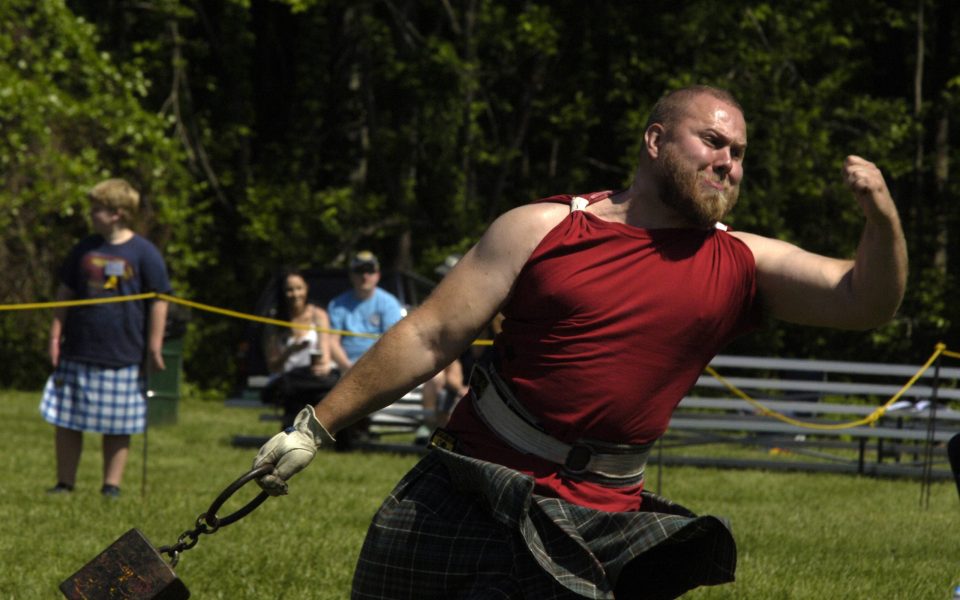By Jeff Laughlin
The pole sat at world-record height while Travis Gardner stuck a custom-made pitchfork through a 16-pound bag. To win the sheaf toss, he would have to toss that bag backwards over his shoulder and clear a marker almost 40 feet high.
Meanwhile, in the distance, the band Barleyjuice played a snarling Scots-Irish folk version of the Rolling Stones’ “You Can’t Always Get What You Want.” If folk covers and world records don’t sum up the experience of the Triad’s version of the Highland Games, I’m not sure what would.
Walking around the different clan booths — each with specialized tartans and flags — gave the games more gravitas than the groups of burly men throwing giant stones from a standstill. The festival had a half-heritage, half-awe vibe to it. A prideful people showcased their strong connections to a longstanding nation, but also some dudes were throwing heavy rocks as far as they could while grunting and screaming.
Obviously, people were digging the grunting and screaming.
Centered around nine events, the Highland Games often get confused with strongman and lumberjack competitions. While the comparisons make sense, they do not quite capture the dexterity of athleticism these participants must display. Rob Hatch, who had the best throw in the caber toss, understands that all too well.
“It takes good balance of strength and athletic ability to do these events. Some of these guys are track coaches and former ballplayers,” Hatch said.
What look like contests of raw, animal power actually require serious range of motion. “Sure, you need some power-lifting ability, but I actually benefitted from not having power-lifted a lot when I was young. My joints and my knees are clean,” Hatch said.
To his point, he got a running start and threw a perfect caber toss, known as a “12 o’clock throw.” He finished the day as the only participant to officially take the 20-foot caber — a stripped-down tree that looks like a telephone pole — and flip it over from the bottom. Scott Medlin, announcer and one of the event organizers, hammered home why this throw looked so simple yet impressed the athletes and crowds so much.
“The caber toss is the most popular event. It’s the easiest obstacle for a crowd to see. But there is so much going on that the crowd can’t see,” Medlin said.
A tosser picks the caber up slowly and balances it vertically against his frame. He adjusts for the wind and his grip. He runs for momentum before flipping the caber upwards, with an eye towards flipping it a half turn, like a dive, then dropping away from the launch site upon landing. He’ll be judged not on distance or time, but on the degree to which the tree lands and falls.
Just flipping a telephone pole would be too easy.
Hatch’s perfect throw delighted the onlookers, but it wasn’t always so easy.
“It took me three competitions to even get my grip right in the caber. I had to learn by doing it wrong,” Hatch said.
Like most of the events, caber toss has historical value. In Scottish warfare, stronger soldiers would lean trees on the sides of castle walls to allow more lithe soldiers to climb them and open castle doors from the inside.
In the hammer toss, players wore long spikes extending from the front of their shoes. This kept them from being able to turn their bodies and throw forward. This particular version of the hammer evolved from the 14th Century, when the British banned weapons of war in Scotland.
The only event that did not originate in Scotland came from America — the aforementioned sheaf toss. Meant to resemble a bushel of hay, participants tossed 16-pound bags of hay over a bar set to unimaginable heights.
Being a professional at an amateur event, Gardner’s throw meant nothing to the world record. The pros toss 20-pound bags. Still, he harnessed the cargo and heaved it backward. The bag sailed over the bar, clearing it by a scant centimeter or two. Though the record books will not change, the crowd appreciated Gardner’s effort.
Barleyjuice wrapped up their folky Stones cover and the crowd dispersed to await the final event of the day. Some bought traditional Scottish faire, some wandered toward a blindfolded competition where women judged men solely on their knees.
By the time Gardner began throwing 56-pound weights over his shoulder using just one arm, onlookers had seen enough. Humanity can watch only so many physical limits pushed before they wander on, proving the old British proverb true.
You can’t always get what you want, but if you try sometimes, you just might find you get what you need.
Join the First Amendment Society, a membership that goes directly to funding TCB‘s newsroom.
We believe that reporting can save the world.
The TCB First Amendment Society recognizes the vital role of a free, unfettered press with a bundling of local experiences designed to build community, and unique engagements with our newsroom that will help you understand, and shape, local journalism’s critical role in uplifting the people in our cities.
All revenue goes directly into the newsroom as reporters’ salaries and freelance commissions.


Leave a Reply